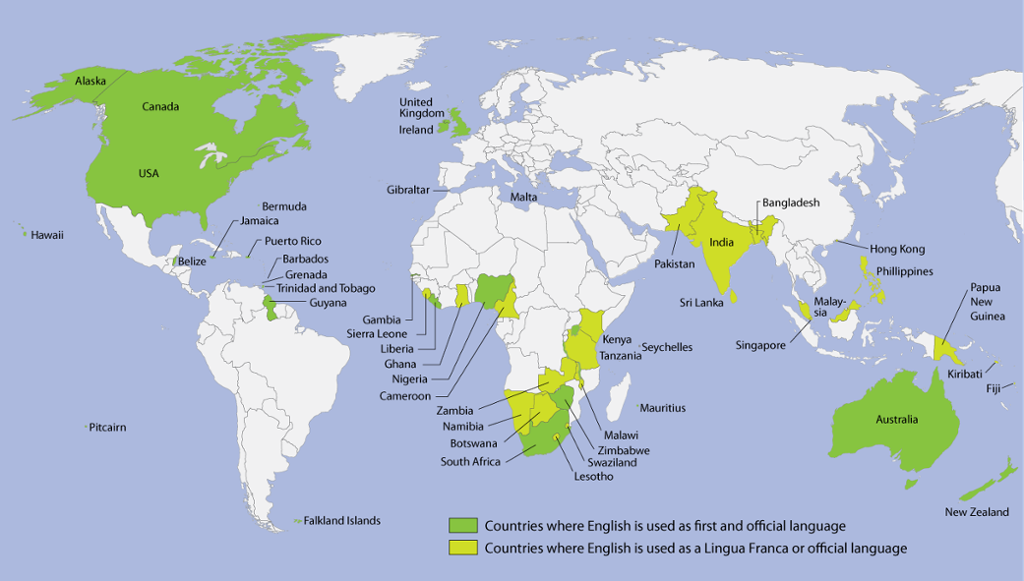Standard English – One of Many Varieties of English

English is the mother tongue of almost 380 million people around the world. In addition, it is used as a second language by close to 740 million people worldwide. There are several regional varieties of English: General Australian, Standard British English, General American, Standard Scottish English, etc. What is SE in Britain is different from the accepted SE of the United States, India, or Canada. Spelling and grammar may differ slightly, and there will be local words and idiomatic expressions. However, the variants are still mutually intelligible.
In their written forms, different standards of English do not vary to any significant degree. Essentially, there are two main variants of standard written English used in the world today, British English and American English, with variants subordinate to one or both of them. For example, countries in Central and South America, as well as Asian-Pacific countries (Japan, South Korea, and the Philippines), have a preference for American English. Other countries, such as Australia and South Africa, have written standards that maintain close links to British English. Written standard Canadian English, however, uses spelling from both British and American English, reflecting the historical relationship to Britain and contemporary influence from the United States.
According to British linguist David Crystal, the Standard English of an English-speaking country may be defined as
a minority variety (identified chiefly by its vocabulary, grammar, and orthography) which carries most prestige and is most widely understood.
What does this definition tell you?
David Crystal points out that SE is merely one of many variants of English in an English-speaking country. It is widely understood by most people in the country, but only a minority of the people use it in their everyday speech. The linguistic features of SE are primarily features of grammar, vocabulary, and spelling. Pronunciation is less relevant, since SE can be spoken with a wide variety of accents. In writing, which is where SE is used the most, the consistent use of SE is only required in certain tasks such as formal letters, reports, newspaper articles, school essays, etc.
In spite of SE being a minority variety, it carries more prestige than other varieties of English, and is often adopted by people who in some way have a greater influential force on society than others (e.g. people with political or economic power, people from higher social classes or with a certain educational background, etc). According to the American linguist James Sledd, SE is ‘the English used by the powerful’. The prestige that is attached to SE makes it the preferred variety of communication in the leading institutions of a country, such as its government, courts, public services, the media, and its educational institutions. Also, it is the variety of English that is taught to foreign learners of English - like you.
Is it fair to say that Standard English is more correct than non-standard English, such as dialects, regional accents, and sociolects? SE has often been defined as the only proper, correct English. Non-standard varieties of English, on the other hand, have often been associated with low status and poor education, and have at times contemptuously been labelled as 'broken English', 'gutter English' or 'substandard English'.
However, we often forget that Standard English (irrespective of which national Standard English we are talking about) is a minority variety. Most people master and understand SE because that is the language of education and public life. However, only about 10% of native English speakers choose to use SE as their everyday dialect. Non-standard English variants, with their unique grammar, slang, and pronunciation, are far more common, and we can hear people from all walks of life using non-standard words and phrases in their spoken English. For example, double negations are not uncommon (i.e. ‘That won’t do you no good’). The same can be said about words like 'ain’t' and 'innit'; words that are not accepted in SE. The fact is that the great majority of native English speakers use a non-standard form of English, which can be very different from SE.
There are many misconceptions about what is 'correct' and 'incorrect' English. The fact is that no varieties of English are 'right' or 'wrong', 'better' or 'worse'. However, some ways of speaking and writing are just better suited to different situations and audiences. What type of English you use is more a matter of appropriateness than of correctness. In a formal setting, it is natural to opt for SE, as it is the variant that will ensure that you are easily understood. Opting for a non-standard variant may cause confusion and misunderstandings. People may also have various prejudices against non-standard variants of English, so using SE leaves less room for people to pre-judge you and what you have to say.
Dialects and accents only enrich the linguistic landscape that we find in the English-speaking world. However, it is essential to know when it is most appropriate to use Standard English and when you should use non-Standard English, and to be able to code switch between the two.
Related content
Tasks related to the article 'What Exactly is Standard English?'